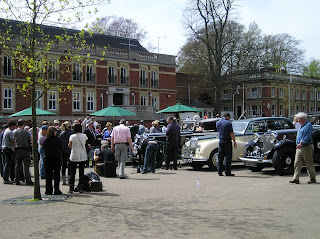



Key dates
1851 - 1866 Livesley Powell & Co. Old Hall Lane and Miles Bank, Hanley.
1867 - 1878 Powell & Bishop. Parliament Row and Stafford Street Works, Hanley.
1878 - 1891 Powell, Bishop & Stonier. Stafford Street Works, Hanley.
1891 - 1933 Bishop & Stonier. Various addresses, Hanley.
1933 - 1939 George Jones & Sons bought the company and continued use of the Bisto trade mark.
Livesley Powell & Co. was formed in 1845 by William Livesley, Edwin Powell and Frederick Bishop. The Livesley family were potters in Hanley; Edwin Powell was a potter who had been apprenticed at Dimmocks of Hanley; and Frederick Bishop was a lawyer providing financial support to the venture.
In 1866 William Livesley retired and the partnership became known as Powell and Bishop. In 1878 Powell and Bishop were joined by John Stonier who was a china and glass merchant in Liverpool, employing around 400 people. One of his company's specialities was fitting out liners of the day, such as Brunel's Great Britain and the ill-fated Titanic.
Livesley Powell produced a variety of bodies including china, parian, and ironstone china and used transfer printing (sometimes in lilac), moulded, painted and lustre decoration. They patented a process of printing in gold and colours which produced a dead gold background. Much of their production was exported, with over one million different items sent to New York alone in 1851. They are reported to have exhibited at the 1851 Great Exhibition. Marks on their wares incorporate the name of the firm or the initials L.P. & Co.
In 1876, Powell and Bishop exhibited at the Philadelphia Exhibition.
In 1880, Powell, Bishop and Stonier registered a new trademark to accompany their ivory or cream coloured earthenware. This shows a seated Chinaman under a sunshade or umbrella containing the words ORIENTAL IVORY - their name for the earthenware body. This oriental ivory body and their green bodied porcelain were ideal vehicles for Japanese inspired designs which were popular in the Victorian period. These often featured asymmetrical floral and bird designs.
In 1891 Duncan Watson Bishop and John Stonier created a new company trade mark BISTO, using the first letters of their surnames. This name was incorporated into the backstamp of the period - the Wand of Caduceus. In 1906 they were using an advertising slogan in the trade press ' The sun never sets on Bisto wares'.
In the 1920s a new range of designs using bright and lustrous colours was produced, known as 'Aztec Ware' . Children's nursery ware was also produced featuring nursery rhymes and stories. Other wares of the 20th century period included bathroom sets, vases and sardine dishes. In 1933, the company was taken over by George Jones & Sons. They continued to use the wand mark and also the mark of a bishop until 1939.









 Here is just a small selection of the jugs in my collection; they line the top of one of my bookcases and show a timeline of manufacture through the various partnerships. The oldest is an L&P (Livesley Powell) jug with beautiful flower and bird transfer print design and handpainted enamel colouring. There is another of a similar design from the oriental ivory range called "Wild Rose", made by the partnership of Powell Bishop & Stonier. The tall thin jug with the Deco interpretation of a Pre-raphelite woman is a very interesting and rare Bisto design. The pattern was designed by Louis Rhead (of the famous Rhead family....Frederick....Charlotte) who was a well-known illustrator who travelled to America and France. This image was used for The Sun magazine which in itself makes it very appropriate that Bisto should use it because one of their marketing mottos was, "the Sun never sets on Bisto wares", probably referring to their widespread export to all four corners of the globe. Indeed, by this stage in the company's history, it really was a worldwide trading empire!.
Here is just a small selection of the jugs in my collection; they line the top of one of my bookcases and show a timeline of manufacture through the various partnerships. The oldest is an L&P (Livesley Powell) jug with beautiful flower and bird transfer print design and handpainted enamel colouring. There is another of a similar design from the oriental ivory range called "Wild Rose", made by the partnership of Powell Bishop & Stonier. The tall thin jug with the Deco interpretation of a Pre-raphelite woman is a very interesting and rare Bisto design. The pattern was designed by Louis Rhead (of the famous Rhead family....Frederick....Charlotte) who was a well-known illustrator who travelled to America and France. This image was used for The Sun magazine which in itself makes it very appropriate that Bisto should use it because one of their marketing mottos was, "the Sun never sets on Bisto wares", probably referring to their widespread export to all four corners of the globe. Indeed, by this stage in the company's history, it really was a worldwide trading empire!.
